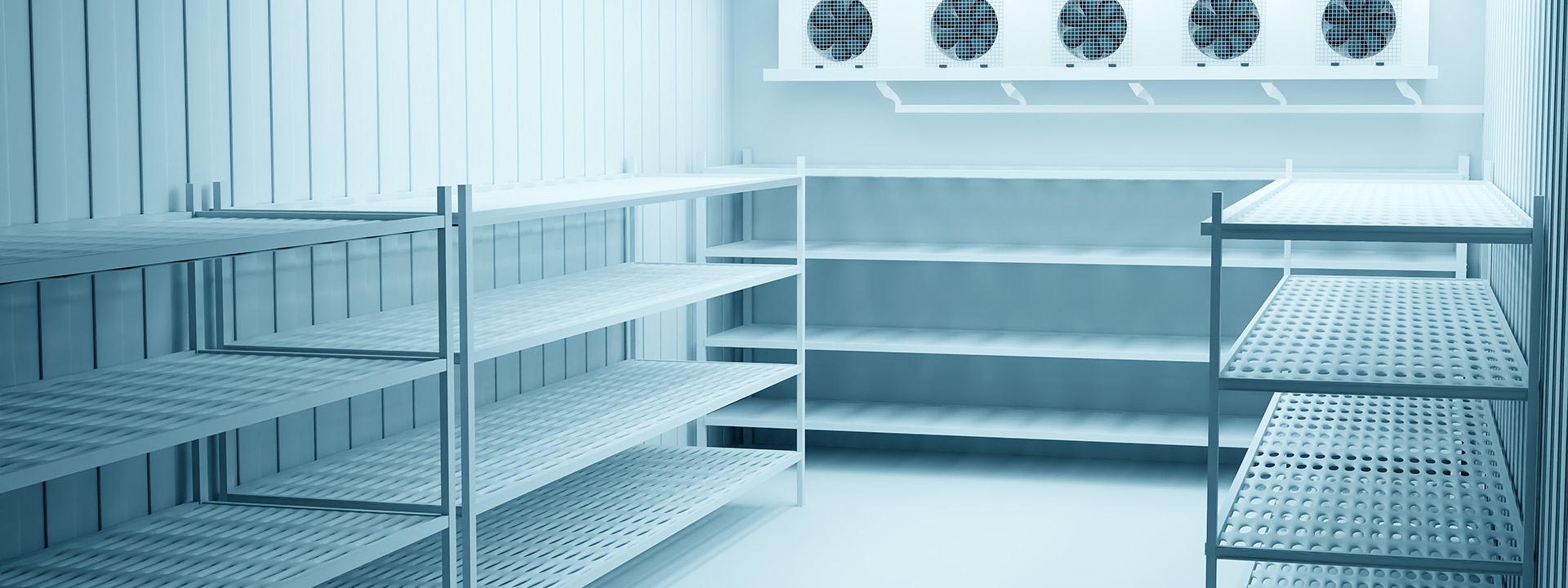
13 Apr Cool solutions for cold environments
Experts advise focusing on structure, safety, and automation when implementing new storage racking in today’s fast-paced temperature-controlled facilities.
When it comes to maintaining a safe and efficient cold storage warehouse, material handling experts say it’s best to start with the basics. And that means the right storage racking, which can serve as a building block in today’s fast-paced refrigerated and freezer environments. The need for freshness means that products are moving in and out quickly in these settings, increasing the risk of equipment damage and employee injuries, and putting quality and safety at the top of any warehouse manager’s operations checklist. Rising demand for cold storage nationwide is exacerbating the trend.
“In these environments, there are a lot of fast-moving parts [because you’re] bringing in and taking out product at a very high rate. … People operating lift equipment are moving at such a fast pace, there’s a higher probability of damage with the racking itself,” explains Skip Eastman, former CEO and current board member at Twinlode Corp., the parent company of Indiana-based material handling solutions provider Twinlode Automation. “And if we’re talking about a freezer, people can’t stay in there for an excessive amount of time, even with insulated clothing.”
As a result, Eastman and others say good design and proper installation of racking systems is taking on a higher profile today, especially as organizations look toward automated solutions to boost efficiency and productivity. This applies to all types of rack solutions, from standard storage racking to pallet flow rack to systems that incorporate conveyors and automated storage and retrieval (AS/RS) solutions. Whether a company is looking for better ways to maintain its current system or ideas for implementing a new one, the experts say leaders should focus on three essential points: structure, safety, and automating for the future.
“The racking and storage design in any temperature-controlled warehouse should be, first and foremost, structurally sound, installed with flexibility in mind, and built for the long term,” says Justin Kukal, vice president of automation strategy and implementation for Agile Cold Storage, an Atlanta-based company launched this year that is building a nationwide network of automated and conventional temperature-controlled warehouses. “A quality manufacturer and steel supplier make or break your long-term rack investment.”
Structurally Sound
Eastman agrees that structure makes a difference in harsh environments and says that racks made from structural steel are the best option for cold or freezer storage, where lower temperatures can affect the toughness of the racking system, making it more susceptible to damage if hit by a forklift or other equipment. Structural steel rack is hot rolled, its components welded together, making it strong enough to support very heavy loads and better able to withstand forklift impact. In comparison, roll-formed rack is cooled and then molded into different shapes and often features adjustable supports and shelves. This type of racking is often more versatile but not as durable in cold environments. Eastman also recommends reinforcing the structural steel supports and adding impact protection on the aisles of cold storage racking to help minimize damage from forklifts or other equipment—again, because the harsh environment can increase the risk of damage from impact.
“[In my experience], customers who do that have fewer problems with trying to replace parts after they are damaged,” he explains.
Burnie Taylor, COO and senior vice president at Agile Cold Storage, agrees, adding that the evolution of rack design and other technologies allows for better solutions across the board. As one example, he says low-oxygen fire-prevention technology—which reduces the oxygen in an environment to a level that keeps fires from igniting—eliminates the need for in-rack sprinkler systems and has made it more feasible to build higher structures that better utilize a facility’s cubic capacity. Such systems are often implemented in AS/RS environments, where human exposure to low oxygen can be minimized.
“Better manufacturing processes have increased the tensile strength of racking, and designs are being engineered to last,” adds Taylor. “The sub-technologies that work within the racking, such as fire protection and prevention, have evolved as well, allowing for taller and less-intrusive rack designs.”
Eastman says the finish on the rack is important too. Products must be processed, cleaned, and painted properly to avoid peeling and to withstand cleaning and sanitizing processes, which vary based on the customer’s operation. More complex systems—those that involve conveyors or other automation, for instance—may need to include shielded or sealed bearings or sealed motors, depending on the environment.
“One of the most important things is that whoever you work with has a clear-cut understanding of your environment,” Eastman says. “You have to select the right people to be working with so they are in tune with what goes on in your organization.”
Safe and Secure
Beginning with a secure structure is the first step toward ensuring a safe racking system. Eastman, Kukal, and Taylor emphasize that the best-quality materials, reinforced and installed properly, will create a solid structure that can withstand the fast-paced traffic and extreme temperatures of a cold-storage environment.
Training is the other key element, according to Taylor. Quite simply, having the right people, with the right equipment, doing the right things is the best way to maintain a safe and efficient culture, he says.
“[Companies should] ensure that employees are trained and equipped with the standard personal protective equipment as well as specialized equipment such as thermal protection and fall protection,” he explains, adding that the advent of high-bay racking—which features multiple levels of storage and allows more pallet locations in a given footprint—has increased the need for safety equipment and training. Such systems take advantage of ceiling height, adding vertical storage that can be accessed via reach trucks, cranes, or automated systems. Depending on the environment, companies may need to add specialized equipment such as narrow-aisle forklifts or personnel lifts and platforms that allow access to the higher levels. All of these scenarios require “a robust safety program for your front-line maintenance and leadership team members,” Taylor says.
Eastman reiterates the importance of working with trusted suppliers.
“There are so many [elements to consider] when it comes to safety,” he says, pointing to local building codes, fire codes, insurance issues, and broader industry guidelines that play into the safe design and installation of racks. “The way we store [items] and the density we’re allowed to store them is predicated on local codes, but you also have to make sure all these are within the requirements of whoever is insuring the building. … [As a result], you need to make sure you are working with people that can help you with the process; they may not have all the answers, but they should be able to help you find them.”
Automate For The Long Term
Automation is quickly becoming a trend in cold storage, and two elements are driving it: speed and a chronic labor shortage. Automation can help improve both safety and productivity in the warehouse, addressing the need to get products in and out quickly in a climate that makes it tough to attract workers. E-commerce is a factor as well. Recent research points to growing demand for cold storage facilities nationwide, in part due to an increase in e-grocery delivery. Online grocery sales are expected to increase 13% by 2022, according to research from commercial real estate giant CBRE. Nearly half of U.S. consumers already shop for packaged food products online, a figure that is expected to rise to 70% by 2022, the company also said. A large portion of that will likely be perishable food items, requiring more freezer/cooler space for storage and distribution, CBRE researchers wrote in a late 2019 report titled Food on Demand: Cold Storage Logistics Unpacked.
A shift toward AS/RS and other automated solutions will help organizations make the best use of those spaces and keep pace with the growing volume of products and deliveries.
“In today’s environment, everything moves even faster than [it did just a few] years ago, so you have to start looking into an automation phase,” Eastman explains.
Automation can reduce employees’ exposure to harsh conditions, for example, and as a result, speed the loading and unloading process while freeing up labor for other warehouse tasks. Eastman points to AS/RS as a common solution in cold storage environments, noting that such systems can be fully automated or semi-automated depending on an organization’s needs. Kukal adds that the broader cold storage industry is moving toward fully automated high-bay rack-supported structures as a way to accommodate demand for more products and faster delivery—a trend that also begins with a “back to basics” approach focused on proper structure and design.
“With high-bay rack-supported structures, you have the ability to maximize the storage density, and the automation eliminates most, if not all, damage caused due to rack strikes by conventional forklifts,” he explains. “The challenge for most racking providers has shifted to including the load requirements for the structures as well as the pallet loads being stored.”
View original article here.


